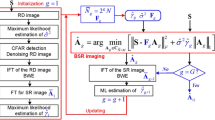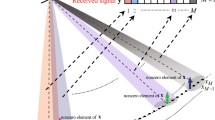Abstract
A compressed sensing method with basis selection is applied to a millimeter-wave synthetic aperture radar (SAR) imaging system. With a large candidate set of bases to choose from and without any a priori knowledge of the proper basis, the proposed method selects the sparsifying basis during the first few iterations of the L1 optimization according to the information from incomplete measurements and the coherence between the measurement matrix and sparsifying matrices. Several decision metrics can be used to select the basis, including the impulsiveness and Gini index of the available image at the current iteration. The proposed method is tested on two examples: a simulated image and its SAR measurement, and an experimental measurement obtained at 150 GHz via roaster scanning. The results from the simulation and experiment indicate that the proposed algorithm can always find a very good basis from the set of over 270 bases within the first two to five iterations of the L1 optimization.










Similar content being viewed by others
References
M. Aharon, M. Elad, A. Bruckstein, K-SVD: an algorithm for designing overcomplete dictionaries for sparse representation. IEEE Trans. Signal Proc. 54, 4311–4322 (2006). doi:10.1109/TSP.2006.881199
C.M. Akujuobi, O.O. Odejide, A. Annamalai, G.L. Fudge, Sparseness measures of signals for compressive sampling, in IEEE International Symposium on Signal Processing and Information Technology (2007), pp. 1042–1047. doi:10.1109/ISSPIT.2007.4458145
C.D. Austin, E. Ertin, R.L. Moses, Sparse signal methods for 3-D radar imaging. IEEE J. Sel. Top. Signal Process. 5, 408–423 (2011). doi:10.1109/JSTSP.2010.2090128
E.J. Candes, J. Romberg, T. Tao, Robust uncertainty principles: exact signal reconstruction from highly incomplete frequency information. IEEE Trans. Inf. Theory 52, 489–509 (2006). doi:10.1109/TIT.2005.862083
E.J. Candes, M.B. Wakin, An introduction to compressive sampling. IEEE Signal Process. Mag. 25, 21–30 (2008). doi:10.1109/MSP.2007.914731
J.T. Case, S. Kharkovsky, R. Zoughi, G. Steffes, F.L. Hepburn, Millimeter wave holographical inspection of honeycomb composites. 975, 970–975 (2008). doi:10.1063/1.2902771
H.W. Chen, L.W. Kang, C.S. Lu, Dictionary learning-based distributed compressive video sensing, in Picture Coding Symposium (PCS) (2010), pp. 210–213. doi:10.1109/PCS.2010.5702466
I. Daubechies, Ten Lectures on Wavelets (SIAM, PA, 1992). doi:10.1137/1.9781611970104
D.L. Donoho, Compressed sensing. IEEE Trans. Inf. Theory 52, 1289–1306 (2006). doi:10.1109/TIT.2006.871582
J.M. Duarte-Carvajalino, G. Sapiro, Learning to sense sparse signals: simultaneous sensing matrix and sparsifying dictionary optimization. IEEE Trans. Image Process. 18, 1395–1408 (2009). doi:10.1109/TIP.2009.2022459
H. Kajbaf, J.T. Case, Y.R. Zheng, S. Kharkovsky, R. Zoughi, Quantitative and qualitative comparison of SAR images from incomplete measurements using compressed sensing and nonuniform FFT, in IEEE Radar Conference (Radar’11) (2011), pp. 592–596
H. Kajbaf, Compressed sensing for 3D microwave imaging system. Ph. D. dissertation, Missouri University of Science and Technology, Chapter 3 (2012). doi:10.1109/RADAR.2011.5960606
H. Kajbaf, J.T. Case, Z. Yang, Y.R. Zheng, Compressed sensing for SAR-based wideband 3D microwave imaging system using nonuniform FFT. IET Radar Sonar Navig. (2013). doi:10.1049/iet-rsn.2012.0149
S. Kharkovsky, R. Zoughi, Microwave and millimeter wave nondestructive testing and evaluation: overview and recent advances. IEEE Instrum. Meas. Mag. 10, 26–38 (2007). doi:10.1109/MIM.2007.364985
T. Goldstein, S. Osher, The split Bregman algorithm for L1 regularized problems. UCLA CAM Report (2008), pp. 08–29. doi:10.1137/080725891
N. Hurley, S. Rickard, Comparing measures of sparsity, in IEEE Workshop on Machine Learning for Signal Processing (2008), pp. 4723–4741. doi:10.1109/MLSP.2008.4685455
M. Lustig, D.L. Donoho, J.M. Pauly, Sparse MRI: the application of compressed sensing for rapid MR imaging. Magn. Reson. Med. 58, 1182–1195 (2007). doi:10.1002/mrm.21391
G. Peyré, Best basis compressed sensing. IEEE Trans. Signal Process. 58, 2613–2622 (2010). doi:10.1109/TSP.2010.2042490
L.C. Potter, E. Ertin, J.T. Parker, M. Cetin, Sparsity and compressed sensing in radar imaging. Proc. IEEE 98, 1006–1020 (2010). doi:10.1109/JPROC.2009.2037526
P. Purkait, B. Chanda, Super resolution image reconstruction through Bregman iteration using morphologic regularization. IEEE Trans. Image Process. 21, 4029–4039 (2012). doi:10.1109/TIP.2012.2201492
S. Ravishankar, Y. Bresler, MR image reconstruction from highly undersampled k-space data by dictionary learning. IEEE Trans. Med. Imaging 30, 1028–1041 (2011). doi:10.1109/TMI.2010.2090538
T.A. Schonhoff, A.A. Giordano, Detection and Estimation Theory and Its Applications (Prentice Hall, Englewood Cliffs, 2006)
A. Soni, J. Haupt, Efficient adaptive compressive sensing using sparse hierarchical learned dictionaries, in 2011 Conference Record of the Forty Fifth Asilomar Conference on Signals, Systems and Computers (ASILOMAR) (2011), pp. 1250–1254. doi:10.1109/ACSSC.2011.6190216
M. Soumekh, Bistatic synthetic aperture radar inversion with application in dynamic object imaging. IEEE Trans. Signal Process. 39, 2044–2055 (1991). doi:10.1109/78.134436
Stanford University, WaveLab 850. http://statweb.stanford.edu/~wavelab/. Retrived Feb. 2014
J.J. Thiagarajan, K.N. Ramamurthy, A. Spanias, Multilevel dictionary learning for sparse representation of images, in Digital Signal Processing Workshop and IEEE Signal Processing Education Workshop (DSP/SPE) (2011), pp. 271–276. doi:10.1109/DSP-SPE.2011.5739224
Z. Wang, A.C. Bovik, H.R. Sheikh, E.P. Simoncelli, Image quality assessment: from error visibility to structural similarity. IEEE Trans. Image Process. 13, 600–612 (2004). doi:10.1109/TIP.2003.819861
J. Yang, Y. Zhang, Alternating Algorithms for \(\ell _1\)-Problems in Compressive Sensing. Rice University CAAM. http://www.caam.rice.edu/~zhang/reports/tr0937 (2010). doi:10.1137/090777761
Z. Yang, Y.R. Zheng, Near-field 3-D synthetic aperture radar imaging via compressed sensing. IEEE ICASSP 25–30, 2513–2516 (2012). doi:10.1109/ICASSP.2012.6288427
Z. Yang, Y.R. Zheng, A comparative study of compressed sensing approaches for 3-D synthetic aperture radar image reconstruction. Digit. Signal Process. 32, 24–33 (2014). doi:10.1016/j.dsp.2014.05.016
D. Zonoobi, A.A. Kassim, Y.V. Venkatesh, Gini index as sparsity measure for signal reconstruction from compressive samples. IEEE J. Sel. Top. Signal Process. 5, 927–932 (2011). doi:10.1109/JSTSP.2011.2160711
Acknowledgments
The work of Dongjie Bi and Yongle Xie was supported by the National Natural Science Foundation of China (61371049) and the Specialized Research Fund for the Doctoral Program of High Education of China (20120185110013). The work of Dongjie Bi was performed during his visit at Missouri University of Science and Technology. The work of Yahong Rosa Zheng was supported in part by the Intelligent Systems Center of Missouri University of Science and Technology, the Inter-Discipline Inter-Campus research program of University of Missouri systems, and the Technology Research Institute of Austin. The authors wish to thank Dr. Kristen Donnell of Missouri University of Science and Technology for providing the SAR measurement data in Fig. 6 and Mr. Zengli Yang of Missouri University of Science and Technology for providing the simulation program that generated Fig. 1a.
Author information
Authors and Affiliations
Corresponding author
Rights and permissions
About this article
Cite this article
Bi, D., Xie, Y. & Zheng, Y.R. Synthetic Aperture Radar Imaging Using Basis Selection Compressed Sensing. Circuits Syst Signal Process 34, 2561–2576 (2015). https://doi.org/10.1007/s00034-015-9974-y
Received:
Revised:
Accepted:
Published:
Issue Date:
DOI: https://doi.org/10.1007/s00034-015-9974-y




